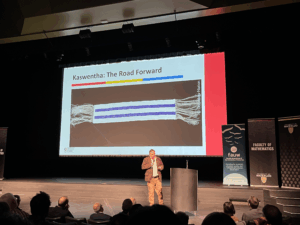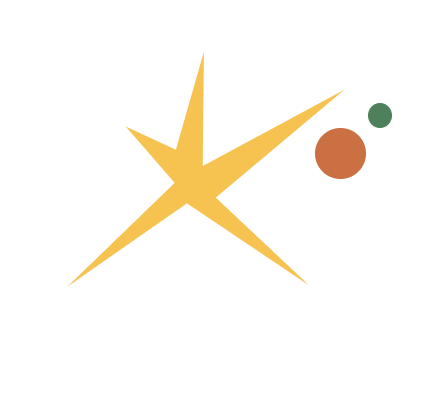Indigenous Canadian mathematician provides movement in “right direction” in 2025 Hagey Lecture
For this year’s Hagey Lecture, Edward Doolittle, the first self-identified Indigenous Canadian person to receive a PhD in math, presented a summary of the work he’s done on Indigenous mathematics, a branch he’s been studying for 40 years. Throughout the presentation, he emphasized the existing connection between spirituality and mathematics, encouraging his audience to work on bringing that to students.
His presentation began with an explanation of the tools underlying Indigenous mathematics, focusing on the spiritual aspect of the Medicine Wheel.
In one example, he recounted the Haudenosaunee creation story, explaining that Sky Woman, pregnant in Sky World and craving a certain root, dug a hole so deep she fell from Sky World into this world.
Doolittle recognized the difficulty that oral traditions can impose on passing down knowledge, and said that the creation story is structured around numbers from one to ten as a memory aid, using this as an example of the effect that openness to spiritual thinking can have.
“Sometimes people say, ‘This mathematics thing, we didn’t have it in ancient times, so what’s the big deal? Why do we need to learn mathematics now?’…The numbers are embedded in creation. The numbers are part of creation.”
Doolittle said that a more systematic way of building spirituality into mathematics that he found was a project revolving around a mathematics bundle, which elder Betty McKenna, a lecturer at First Nations University, suggested the creation of. Doolittle explained that a bundle is a container for important objects, memories, thoughts, and ideas, that it has “a life of its own.”

Professor Edward Doolittle explains the Kaswentha. Photo Alicia Wang
To evolve the bundle, Doolittle, McKenna, and other researchers organized a workshop at Banff International Research Station with colleagues from around the world. Upon arriving at the workshop, Doolittle had a vision of a Kaswentha, a beaded belt with two rows of blue beads running parallel across the length of the belt, often translated to English as wampum.
“The best that I’ve been able to find is that Kaswentha is a description, as many words in Mohawk are,” he said, “…and what it describes is something that is flowing, but structured.”
Doolittle said he has only experienced strong visions like this four other times in his life. “So I thought, ‘why am I seeing this?’ And then I heard a phrase: closing the gap.”
To Doolittle, this proposal is a mistake. He said that although there are often proposals to “braid” Indigenous knowledge and Western knowledge, “This Kaswentha does not agree. We’re not braiding here. Our knowledge system stands on its own, is what this says.”
Doolittle said that when asking Indigenous communities what they wanted out of mathematics, one community in Northern Ontario answered that they wanted young people to be able to survive in the bush through hunting, gathering, and building shelters. “I’m like, ‘Well, the Ontario math curriculum is not going to help you with that.’ So, who are we to say that’s not a worthwhile pursuit?”
In an interview with Imprint afterwards, Doolittle said that now was the time to focus on what goes on in classrooms.
“We need to now put together teams of negotiators that say, ‘this is what we really want out of education,’ and I think we’re at a place now where we have the expertise and the digital communities and the knowledge and the theoretical framework for how to do that.”
Jean Becker, associate vice president of the Office of Indigenous Relations, said that the talk expands what Indigenization is about, particularly when it comes to education. “The universities generally tend to see it as kind of ‘add a few Indigenous students, maybe hire a person or two,’ but they don’t really get that there’s a body of knowledge that could be enriching the education of all students.”
Becker said the university is working on creating an Indigenous outdoor education space, intended to bring students to “the real teacher, which is our mother, the earth.”
“I think if we can get that as a site established and begin to incorporate teaching on the land and of the land that it will add a dimension to the university that I couldn’t even begin to describe,” she said.
Sarah Nayar, a third-year math student, said the lecture gave her a lot to think about regarding the two ways of mathematics, and “on the concept of a central curriculum and how we should be talking to Indigenous peoples to inform the way we set our curriculum.”
Andrea Atkins, who emceed the presentation and is a member of the Hagey Lecture Committee as well as an associate professor in architectural engineering, said the talk was movement in the right direction. Though she was “pleasantly surprised” by the turnout from the broader community, she pointed out the remaining work to be done in terms of spreading the message to other educators.
“A lot of people honestly teach the way they were taught. And so there is a lot of, I think, unlearning and relearning that needs to happen at the faculty level,” she said, adding that challenging people is a “good way,” especially when providing academics with “that little brainworm that’s going to have us think about it for a while.”
During his presentation, Doolittle highlighted the growth of the Indigenous Canadian math community and the importance of facilitating that trend. “I’m not absolutely sure I was the first Indigenous person to get a PhD in mathematics because we rely on self identification. But it could be,” he told Imprint. “And what we’re seeing, I think, is exponential growth, which starts out very slowly at first. You look at an exponential curve, it starts out very slow, but, you know, you’re going to see a rapid rise in the coming decades. So it’s our time.”
Share this story
More
Campus News, Local News
E-scooters cover 236,000 km across Waterloo region in 2025, WRPS reports 19 collisions
Veronica Reiner
| November 6, 2025
Sports & Health
Athletes of the week: Sydney Batiuk and Callum Myers
Shawn Kouadio
| November 5, 2025



